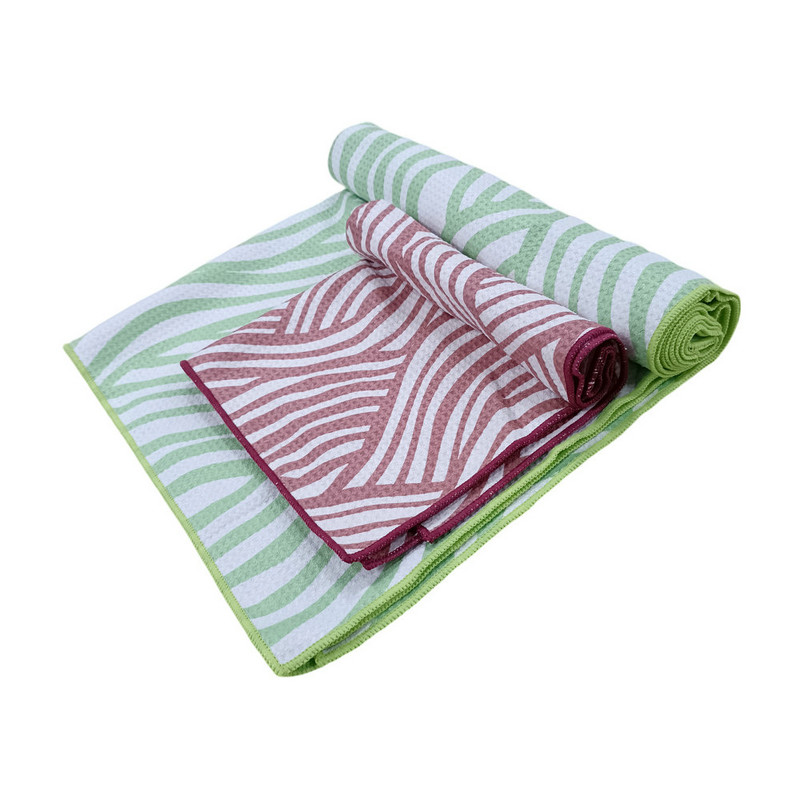If you are interested in some of our products, please feel free to visit our website or contact us for detailed information.
Microfiber beach towels are highly regarded for their resistance to sand, making them a popular choice for beachgoers. This resistance is due to several key properties and characteristics of microfiber material. Here’s an in-depth look at how microfiber beach towels resist sand and the benefits they offer in this regard:
1. Fiber Structure and Texture
Fine Fibers: Microfiber is composed of extremely fine synthetic fibers, typically less than one denier in diameter. These fibers create a very dense weave with a smooth surface, which makes it difficult for sand particles to embed themselves into the fabric.
Tight Weave: The tight weave of microfiber prevents sand from passing through the fabric easily. Unlike traditional cotton towels, which have larger loops and spaces between the fibers where sand can get trapped, microfiber has a much smaller surface area for sand to cling to.
2. Anti-Adhesive Properties
Smooth Surface: The smooth surface of microfiber minimizes friction, reducing the adherence of sand particles. Sand tends to slide off the towel more easily when shaken or brushed.
Electrostatic Properties: Microfiber can generate a slight electrostatic charge that repels particles. This helps in preventing sand from sticking to the towel in the first place.
3. Sand Shedding Ability
Easy to Shake Off: One of the most significant advantages of microfiber towels is how easily they shed sand. A quick shake or flap can remove most, if not all, of the sand, keeping the towel relatively clean and free of grit.
Minimal Residue: Even if some sand does cling to the towel, it typically remains on the surface and is easy to brush off without leaving residue. This contrasts with cotton towels, where sand can become embedded within the loops of the fabric.
4. Dryness and Sand Resistance
Quick Drying: Microfiber towels dry much faster than traditional towels, which reduces the likelihood of wet sand sticking to them. A dry towel naturally repels sand better than a damp one.
Hydrophobic Properties: The synthetic nature of microfiber makes it less absorbent to water than natural fibers like cotton. This means that sand doesn’t stick to the towel when it’s wet, further enhancing its sand resistance.
5. Maintenance and Longevity
Easy Cleaning: Microfiber towels are easy to clean and maintain, which includes removing sand. Simply shaking the towel or washing it can remove any remaining particles effectively.

Durability: The durable nature of microfiber means that it maintains its sand-resistant properties over time. Unlike some materials that may degrade and become more susceptible to sand adherence, microfiber retains its smooth, dense weave and other beneficial properties.
Comparison with Other Towels
Cotton Towels: Traditional cotton beach towels, with their larger fibers and looser weave, are more prone to trapping sand. The sand gets stuck in the loops of the fabric, and it can be challenging to remove without a thorough wash.
Bamboo Towels: Bamboo towels, while more eco-friendly, also tend to have a texture that can trap sand. They don't shed sand as effectively as microfiber towels.
Polyester Towels: Some polyester towels offer decent sand resistance, but they often lack the softness and absorbency of microfiber. Microfiber's finer fibers and tighter weave generally offer superior performance in sand resistance compared to standard polyester towels.
User Experience and Practicality
Beach Convenience: The sand-resistant properties of microfiber beach towels make them particularly convenient for beach outings. Users don’t have to worry about carrying sand back home or dealing with gritty towels, which enhances the overall beach experience.
Multi-Purpose Use: Microfiber towels are also versatile for other outdoor activities like picnics, hiking, or camping, where avoiding sand or dirt is beneficial.
Potential Considerations
Initial Cost: Microfiber towels can be slightly more expensive than traditional cotton towels. However, their durability and sand-resistant properties may justify the cost over time.
Environmental Impact: While microfiber towels are durable and long-lasting, they are made from synthetic fibers, which have a larger environmental footprint compared to natural fibers. The potential for microfiber shedding microplastics during washing is a concern that needs to be managed responsibly.
Microfiber beach towels offer excellent resistance to sand due to their fine fiber structure, tight weave, smooth surface, and easy sand-shedding properties. These features make them a superior choice for beachgoers looking to avoid the inconvenience of sand sticking to their towels. While they may come at a higher initial cost, their practicality and ease of maintenance make them a valuable investment for anyone frequently visiting sandy environments.








